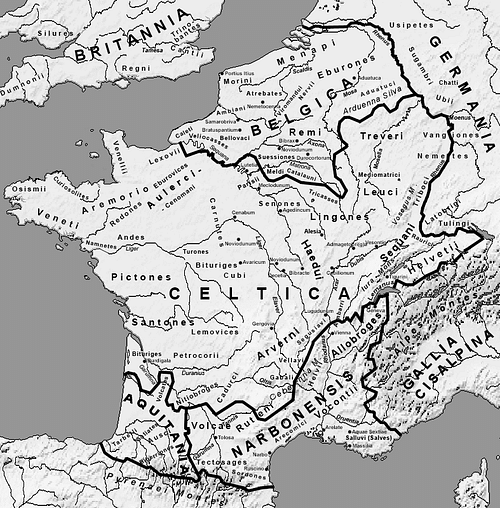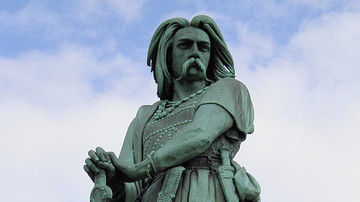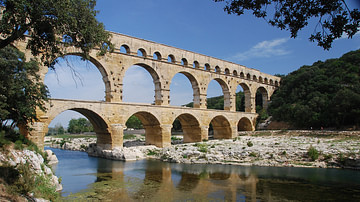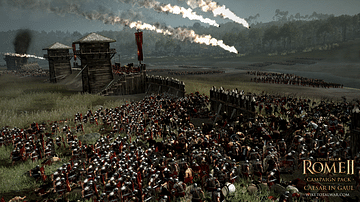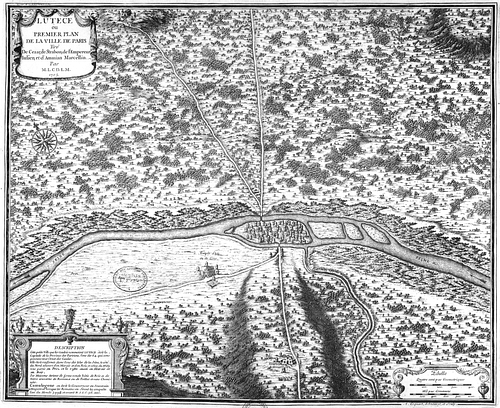
Lutetia Parisiorum was the capital of the Parisii, a tribe in ancient Gaul. The Parisii were a tribe on the Middle Seine, and Lutetia ("place near a swamp") was one of their main settlements. It was on the south bank of the river. In 53 BCE, the Roman general Julius Caesar used Lutetia, which had probably been founded in the mid-third century BCE, as place of the council of all Gallic tribes (Gallic War, 6.3). In the next year, the town supported the rebellion of Vercingetorix (Gallic War, 7.4), and Caesar sent his colonel Titus Labienus with four legions - including VII and XII - to keep control of Lutetia (Gallic War, 7.57). Caesar writes that the Gauls ordered the town to be set afire, but does not mention that this actually happened. Although Labienus defeated his opponents in battle, he was forced to return to the south, where Caesar was facing great troubles. The town's surrender - if anything was left after the fire - is not mentioned in our sources, but is likely to have taken place in 51 BC, after the fall of Alesia.
Lutetia was actually a double settlement. The main part was, originally, a village on the island that is now called Isle de la Cité. Writing during the reign of Augustus, the Greek geographer Strabo says that "the Parisii live round about the Seine, having a city, called Lucotocia (Λουκοτοκία), on an island in the river" (Geography, 4.3.5). The other settlement was a hill fort on the Montagne Sainte-Geneviève. The double town, where a main road from the south to the north crossed the river, was sufficiently wealthy to mint gold coins.
The Romans reorganized the town on their customary gridiron map. It consisted of what is now more or less the Quartier Latin. The two main roads leading from Orleans in the south to the north, the Boulevard Saint-Michel and Rue Saint-Jacques, have ancient predecessors; the latter continued on the north bank of the Seine, where it is now called Rue Saint-Martin. It connected Lutetia to Senlis. Of the east-west roads, the Rue des Écoles and its southern parallel, the Rue Cujas/Rue Clovis are ancient. In the eastern part of the city, the road now called Rue Mouffetard led to Melun. The city rapidly expanded. The elder Pliny mentions the Parisii in his list of notable towns in Gaul (Natural History, 4.107).
No less than three bathhouses have been identified, proving that Lutetia was pretty large: one on the grounds of the Collège de France, another on the Rue Gay-Lussac; one of the rooms of the modern Musée de Cluny is the frigidarium of a third bathhouse. It was built in the third century. Lutetia still flourished during the Gallic Empire (260-274) and was sacked when the emperor Aurelian reconquered this new state and took away the troops from the Rhine frontier: Germanic tribal warriors looted Trier, Metz, Reims, and Lutetia. After all, Lutetia was a prosperous city without walls, almost asking to be pillaged. Since it was now obvious that the city needed defenses, the forum in the south and the island were fortified. The necessary stones were taken from the amphitheater/theater.
By the mid-third century, the city had a Christian community. We do not know much about them, but their presence is logical, because one of them is known to have been martyred: Saint Dionysus (Saint-Denis), who was beheaded during the reign of Valerian. The Pilier des nautes was found underneath the altar of the Cathedral of Notre-Dame, suggesting that there was cultic continuity on the island. The most famous event to take place in Lutetia in Antiquity can be dated to 360, when Julian, consul and caesar of the emperor Constantius II, was proclaimed emperor in a palace (Ammian, Roman History, 20.4-5). This building has not been identified, although in the Middle Ages, it was believed to be identical to one of the bathhouses, which would in the fifteenth century become the palace of the abbots of Cluny.
Lutetia in Late Antiquity will forever be associated with the heroism of Genovefa, better known as Saint Geneviève (c.420-502). The main source for the events is a hagiography, but it seems more or less certain that she was appointed as deaconess by bishop Germanus and impressed the people with her piety, living as a nun. In 451, when the Huns, led by king Attila, were about to attack Lutetia, she convinced the people of Lutetia not to flee. Her prayers were, reportedly, sufficient to save the city - instead, Attila attacked Cenabum (Orleans). She is also associated with bringing food to Lutetia in 464, when the Frankish king Childeric was besieging Lutetia. During this same siege, Geneviève went to the enemy leader and convinced him to take better care of his prisoners of war. The siege led to nothing, and the city was to remain part of the realm controlled by Syagrius, the last Roman governor of this part of Gaul. In 486, these territories were seized by Childeric's son Clovis, to whom Geneviève also paid a visit. He granted her the right to build a monastery. After her death, she was recognized as the patron saint of her city.
